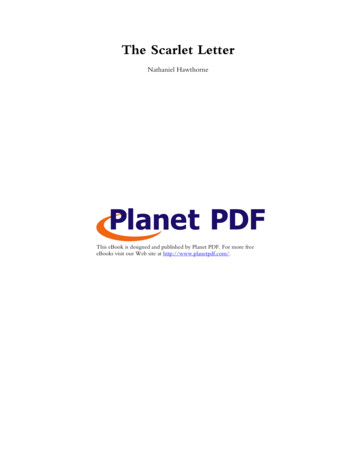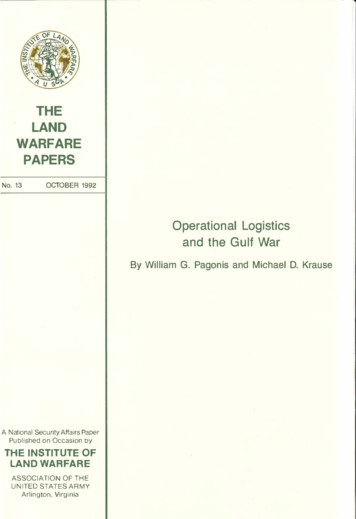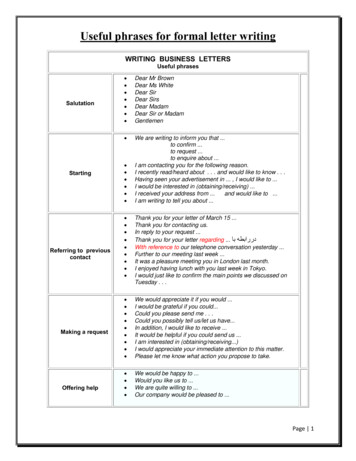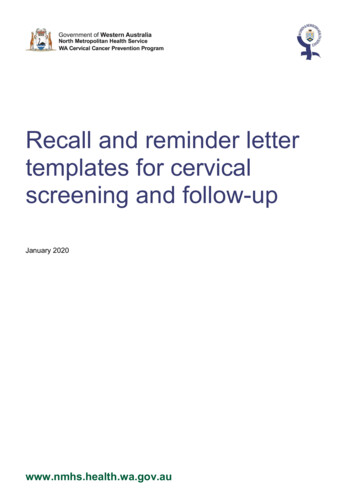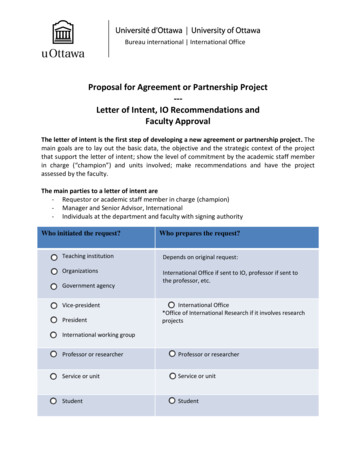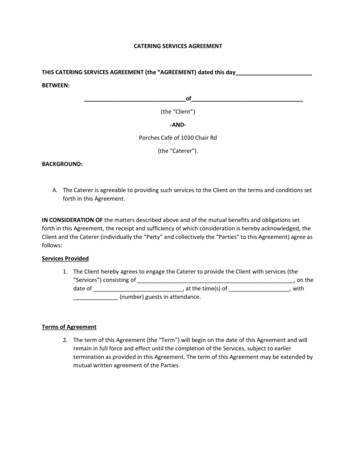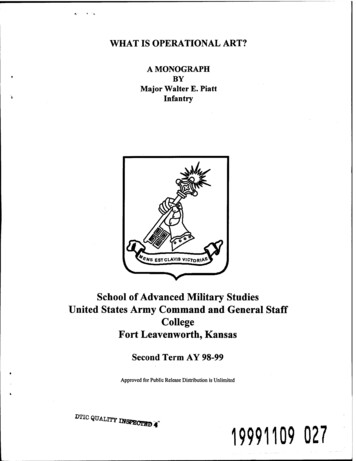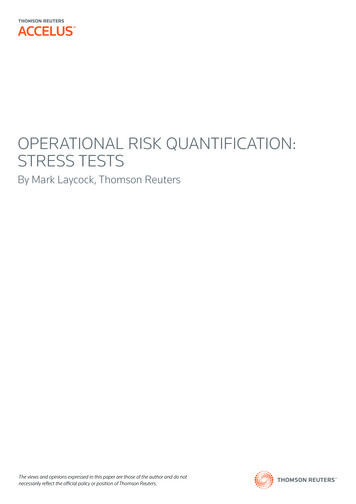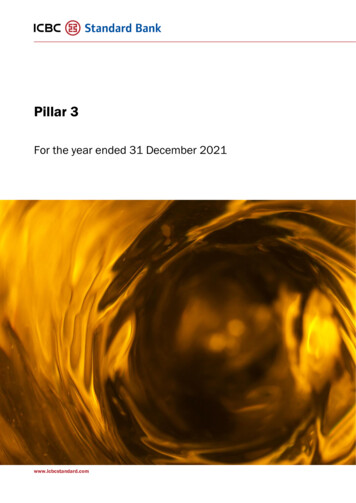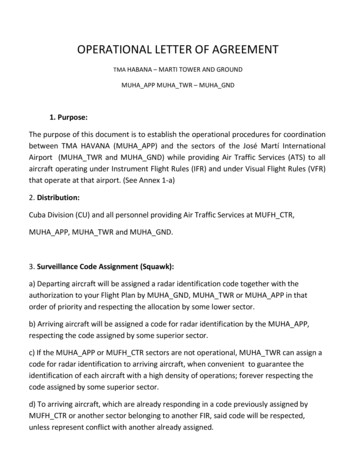
Transcription
OPERATIONAL LETTER OF AGREEMENTTMA HABANA – MARTI TOWER AND GROUNDMUHA APP MUHA TWR – MUHA GND1. Purpose:The purpose of this document is to establish the operational procedures for coordinationbetween TMA HAVANA (MUHA APP) and the sectors of the José Martí InternationalAirport (MUHA TWR and MUHA GND) while providing Air Traffic Services (ATS) to allaircraft operating under Instrument Flight Rules (IFR) and under Visual Flight Rules (VFR)that operate at that airport. (See Annex 1-a)2. Distribution:Cuba Division (CU) and all personnel providing Air Traffic Services at MUFH CTR,MUHA APP, MUHA TWR and MUHA GND.3. Surveillance Code Assignment (Squawk):a) Departing aircraft will be assigned a radar identification code together with theauthorization to your Flight Plan by MUHA GND, MUHA TWR or MUHA APP in thatorder of priority and respecting the allocation by some lower sector.b) Arriving aircraft will be assigned a code for radar identification by the MUHA APP,respecting the code assigned by some superior sector.c) If the MUHA APP or MUFH CTR sectors are not operational, MUHA TWR can assign acode for radar identification to arriving aircraft, when convenient to guarantee theidentification of each aircraft with a high density of operations; forever respecting thecode assigned by some superior sector.d) To arriving aircraft, which are already responding in a code previously assigned byMUFH CTR or another sector belonging to another FIR, said code will be respected,unless represent conflict with another already assigned.
e) If there is a conflict with a surveillance code, the sector with the highest hierarchy willprovide a new conflict-free code to the sector that must be assigned to the aircraft.f) To assign said code, the Cuban Division Squawk Generator must be used. It is presentat the following link:https://www.scumari.nl/squawk/mufhsq.php?id 441685&send Sendor the function of generating Squawk of the AURORA program.4. Activation of Flights (see Annex 1-b):a) MUHA GND will trigger flights departing to MUHA APP when taxiing begins,specifying aircraft identification.b) Said activation must be done via INTERCOM, or alternatively via text message, usingthe channels provided by the IVAC or AURORA control programs.c) MUHA GND will opportunely inform MUHA APP, the Departure Sequence of theaircraft when it differs from the Activation Order.d) It is not necessary to activate local VFR flights, since they are handled by MUHA TWRonly and will not be under the control of MUHA APP.5. Authorization of Flight Plans (See Annex 1-c):a) MUHA GND will issue the Clearances to the IFR flight plans to the departing aircraft.Limited to directly assigning published SIDs/Departure Procedures and will coordinatewith MUHA APP the requests that deviate from said procedures by the aircraft; unlessanother procedure has been coordinated between said sectors.b) MUHA APP will coordinate with MUHA GND any reauthorization or restriction for thedeparting aircraft, in order to guarantee the minimum separation established betweenthe aircraft in the Terminal Area.c) The authorization to the IFR Flight Plan will be delivered to the aircraft using thefollowing format:
“[aircraft identification] cleared to [destination aerodrome] via [SID/ProcedureDeparture Time/Departure Vector] initial climb to [initial flight level/initial altitude]squawk [assigned squawk]”d) Aircraft departing under VFR will be issued the VFR Initial Clearance using the followingformat:“[aircraft identification] provides [VFR Departure Procedure/traffic pattern] to[flight level/altitude] squawk [assigned squawk]”e) Authorizations for flights departing, both IFR and VFR, can be given at any phase of itsground operation; but no aircraft may be cleared to take off without having received andcollated it.f) All aircraft will be authorized to depart at Initial Level FL150 unless they request a Levelo Lower altitude in your Flight Plan, or MUHA APP coordinates a restriction fordeparture.g) If the MUHA APP sectors are not open, MUHA GND will be limited to assigningonly Departure Procedures and SID to departing aircraft, and climb will be authorized tothe Altitude/Flight Level requested in the flight plan.6. Runway in use:a) MUHA TWR will establish the Runway in Use taking into account the direction andintensity of the wind and/or any operational or meteorological reason that limits the useof the runway for takeoff or landing, and will immediately report the decision toMUHA GND and MUHA APP, in such a way that it affects the sequence of arriving trafficas little as possible.b) Frequent changing of the lane in use for short periods of time will be avoided as muchas possible.
c) In case of change of Runway in Use while there is traffic leaving, MUHA GND willcoordinate with MUHA APP, reauthorizations for departing aircraft or restrictions forthose already were activated; as well as the output sequence.d) In case of change of Runway in Use while there is traffic arriving, MUHA APP willcoordinate with MUHA TWR, the sequence of arriving aircraft.e) All sectors (MUHA GND, MUHA TWR, MUHA APP), will inform the aircraft under yourcontrol over Runway In Use changes; and in the case of MUHA APP it will assign to thearriving aircraft, the Instrument Approach Procedure and STAR/Arrival Procedure/Vectoras applicable.f) When an aircraft requests to take off using the Runway in Use in the oppositedirection, MUHA GND must coordinate this operation with MUHA TWR, and this onewith MUHA APP. This operation can only be approved after being coordinated andapproved by the Sector Superior and avoiding interfering with the traffic established bythe Runway in Use. (See Annex 1-d)7. Transfer of Control and Communications (See Annex 1-e):a) MUHA GND will transfer departing aircraft to MUHA TWR reaching the holding pointassigned, unless otherwise coordinated.b) MUHA TWR will transfer the aircraft arriving at MUHA GND when leaving the ActiveRunway unless another procedure is coordinated.c) MUHA TWR will transfer the departing IFR aircraft to MUHA APP together with theauthorization of take off, using the phraseology established for this purpose in theDivision's documentation. If MUHA APP is not available, the IFR aircraft will be instructedto monitor in UNICOM frequency 122.800Mhz. (See Annex 1-e)d) MUHA TWR will immediately transfer to MUHA APP arriving IFR aircraft that start aMissed Approach Procedure, immediately informing MUHA APP of the situation.e) MUHA TWR will transfer VFR aircraft departing to MUHA APP reaching 10NM fromthe center of the airfield. If MUHA APP is not available, the aircraft will be instructed
VFR to monitor on UNICOM 122.800Mhz frequency, having given traffic information ofany VFR aircraft that constitutes Factor. (See Annex 1-e)f) Having previously coordinated with MUHA APP, MUHA TWR can transfer the VFRaircraft leaving the ATZ (3NM from the center of the aerodrome), while does notconstitute a Traffic Factor for other VFR aircraft.g) MUHA APP will transfer IFR aircraft arriving at MUHA TWR over the Approach FixFinal (FAF), established on the Approach Path not more than 7NM from the FAF, or inanother position in the airspace that has been previously coordinated with MUHA TWR.h) MUHA APP will transfer VFR aircraft arriving at MUHA TWR reaching 10NM from thecenter of the airfield; having given him traffic information of any VFR aircraft thatconstitutes Factor; but MUHA TWR will only be able to provide meteorologicalinformation and/or Traffic information to said aircraft until it reaches the ATZ limit (3NMfrom the center of the aerodrome), from which you can exercise control over the aircraft.(See Annex 1-c)8. Separationsa) MUHA APP will establish a minimum separation of 5NM between aircraft in theTerminal Area (TMA).b) MUHA APP will establish a minimum separation between aircraft reaching 5NM in thefinal approach to runway 06 and 7NM on final approach to Runway 24.c) MUHA TWR will establish a takeoff sequence with no less than 4NM or 1 minute ofseparation if the 2nd aircraft develops a speed equal to or less than the preceding one.d) MUHA TWR will establish a takeoff sequence with no less than 10NM or 2 minutes ofseparation if the 2nd aircraft develops a higher speed than the preceding one.9. Communications.a) The frequencies to be used by the Units will be the following:
b) The frequencies can vary through coordination between the activedependencies.10. Other Precisions:a) In accordance with regulation A.2.1.1 of the IVAO Regulation, users must open theMUHA TWR sector before MUHA GND as long as the FRA allows it; being AS2 the MaximumFRA allowed to opening MUHA GND without MUHA TWR being open.b) If there is no MUHA GND, MUHA TWR will assume its functions and obligationsestablished in this Letter of Agreement.c) If there is MUFH CTR, but not MUHA APP, MUFH CTR will assume the functions andobligations of MUHA APP established in this Letter of Agreement.d) Permanent changes to this Letter of Agreement will be specified in the table of revisions atthe end of the document.e) Temporary changes to this Letter of Agreement will be informed and activated by NOTAMand the routes established for this purpose in IVAO.f) At the end of this document, concepts and explanations relevant to the understanding,study and application of this Letter of Agreement as annexes.
This Letter of Agreement will come into effect on 01/October/2021 at 0000UTC.ANNEXESANNEX 1 Concepts and explanations:a) General considerations:The Cuban Division of IVAO (CU-IVAO) is governed by the Guidelines, Procedures and Practicesrecommended by IVAO, but establishes its own Procedures and Recommended Practices foradjust and simulate as far as possible, feasible and permitted, to the Particularities,Procedures, Practices and Regulations established for the Cuban Civil Aviation (real); in orderto provide its members and visitors, both Pilots and Controllers, a simulated experienceasclose to reality.b) Activation of flights:The Activation of the Flights is a coordination procedure between the GND sectors or TWRwith APP so that the latter knows the sequence of aircraft leaving an aerodrome and be ableto plan these departures accordingly, insert them into the sequence of arrivals and issue somerestriction for aircraft to be executed at takeoff.Activation is generally done immediately after instructing the aircraft to taxi, as it is thuspossible to establish a takeoff sequence for departing aircraft; although some airports requireaircraft to “wake up” on start-up. this last is generally established at airports with very lowtraffic density and is always specified in their respective Letters of Agreement with the sectorprovided by the Approach Control Service (APP).For such activation, the following format must be used:“Activate [aircraft identification] [SID/Departure Procedure/Departure Vector]”Example: “Activate ODD211 KAVU5A”
In periods of high traffic density, the controller in the Approach Sector (APP) you have limitedand sometimes no time to constantly check the traffic situation on the ground, therefore, it isnecessary to use tools such as the Flight Activation to be able to plan the departure sequenceand impart any reauthorization or restriction to the aircraft that may cause traffic conflicts. Inthis way, a better service can be provided, with more time to make decisions that if said tool isnot used and APP finds out about the Active Traffics when they are transferred TWR attakeoff.When APP determines it is necessary to issue a reauthorization, it generally coordinates withGND if the aircraft has just started taxiing, but is considered to be about to take off, oradvanced in the taxi operation, it coordinates directly with TWR as a restraint. In this case,TWR will add the restriction to the initial part of the takeoff clearance. as seen in the followingexample:“ODD211, when airborne maintain runway heading until further advice and contact HavanaTerminal on 120 decimal 3, wind 070 degrees 08 knots, clear for takeoff runway 06”c) VFR flights:In the Flight Information Region of the Republic of Cuba (MUFH-FIR), control is exercised on allaircraft regardless of the classification of the airspace in which they are located. For Therefore,aircraft operating under VFR will be provided with traffic information regarding other VFR andIFR aircraft, but in class E airspace, the controller may vector them by separation of traffic withrespect to IFR aircraft that represent a risk of AIRPROX or collision when the transitinformation is not sufficient to resolve the conflict.It will always seek to give priority to traffic information over a separation via vectors, the firstbeing the corresponding service in Echo Class airspace.For this purpose, they will be assigned a Squawk code for their radar identification and mustkeep the controller informed about your altitude or flight level, as well as any changes to thesame.Such control is only allowed above 3000ft AGL, although the aircraft must maintain yourSquawk code below said height.All aircraft under VFR rules flying above 3,000 feet AGL must maintain a VFR levelcorresponding to what is indicated in the AIP. Any descent or ascent to a level/altitude other
than the assigned must be informed to the controller who will authorize it as long as there isno possible conflict with other VFR and/or IFR traffic.In case of conflict, the corresponding information will be provided and the traffic will beinformed when possible proceed to requested altitude/level VFR aircraft must maintainassigned squawk code while in a sector active and until instructed to switch to VFR code.For meteorological information, it is only necessary to indicate: Runway in Use, QNH and somerelevant weather condition affecting the aerodrome.d) Operations on Opposite Runways:Operations along the runway in use always have priority over those using the Opposite Track;except in the case where the aircraft requesting the Opposite Runway has declared anEMERGENCY, or requests it to land and the one using the Runway in Use intends to take off.When an aircraft requests to operate using a Runway Opposite the Runway in Use (directionopposite), it must be indicated that coordination is pending, coordinate the request with thesector immediate superior and if approved, instruct the aircraft to the requested operationtogether with the due reauthorization or restriction for departure.It should be clarified that a request to operate on a runway not in use should not be denied,since the The Pilot in Command of the aircraft is the one who decides if it operates on theRunway in Use or not. In case said operation constitutes or generates a traffic conflict withanother aircraft operating on the runway in use, the applicant must be given the informationof the limiting traffic and the estimated time to wait for be able to execute the operation.If it is intended to carry out the operation interspersed between the traffic of the Runway inUse, must provide traffic information executing the Opposite Runway operation to any aircraftthat may be affected or find itself at some point in opposite defeats with it.e) Phraseology:The phraseology to be used for communications with aircraft is that established by andfor the Cuban Division (CU-IVAO) and published in the Phraseology Manual present in thefollowing link:
ia.pdfPosted on the Cuban Division website.Creator: Luis Orlando CU-AOCTranslator: Ernesto Mesa CU-DIR
MUHA_TWR sector before MUHA_GND as long as the FRA allows it; being AS2 the Maximum FRA allowed to opening MUHA_GND without MUHA_TWR being open. b) If there is no MUHA_GND, MUHA_TWR will assume its functions and obligations established in this Letter of Agreement. c) If there is MUFH_CTR, but not MUHA_APP, MUFH_CTR will assume the functions and .
